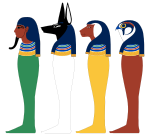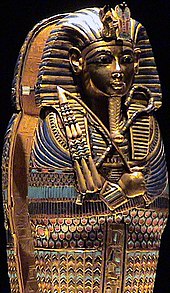Sons of Horus
| Sons of Horus in hieroglyphics | |
|---|---|
| The sons of Horus (from left) Amset, Duamutef, Hapi, Kebechsenuef |
The four sons of Horus (also Horus children or canopic gods ) Amset , Hapi , Duamutef and Kebechsenuef are children of the god " Horus the Elder" ( Haroeris ) and the goddess Isis . They are mainly the protective gods of the canopic jars and come from Buto . This is why the term “the four genii ” (guardian spirit) is sometimes used . As star gods, they are assigned to the four cardinal points, and so at the time of the Middle Kingdom, for example, their names are on the four corners of the coffins.
Representation of the sons of Horus

Up to the 18th dynasty , the sons of Horus had human form in their function as guardians of the bowels of the deceased. This is exemplified by the lids of the canopic jars and the small coffins from the grave ( KV62 ) of Tutankhamun or the four canopic jars found in KV55 . It was not until the 19th dynasty that each canopic lid represented the head of the corresponding son of Horus:
| Horus son | presentation |
|---|---|
| Amset | human |
| Hapi | Monkey (baboon) |
| Duamutef | Jackal (wolf) |
| Kebechsenuef | Bird (falcon) |
However, the assignment of the animal heads of the jackal and the falcon is not entirely clear for both Duamutef and Kebechsenuef. In the literature there are different representations here, which in both cases name the jackal or the hawk for Duamtef and the hawk or jackal for Kebechsenuef.
Importance as the protective gods of the canopi

In the Old Kingdom there were originally only two protective gods of the canopic jars: Amset and Hapi, only later the two other protective gods Duamutef and Kebechsenuef were added and all four were called "Sons of Horus". The pyramid texts represent the four sons of Horus as a kind of guide for the dead man's journey to the hereafter: They take part in the resuscitation, carry him to the grave, open their mouths and take part in the hour watch.
However, their task is primarily to protect the corpse from hunger and thirst and the organs affected by them, the intestines, although the heart and kidneys are not among these organs. The entrails removed during the mummification were wrapped in bandages and separated into four canopic jars, separated into liver, lungs, stomach and abdominal organs, and sometimes also in miniature coffins (canopic coffins). Each jar was under the protection of a son of Horus. Since the New Kingdom there have been the following assignments of the sons of Horus as protectors of the organs:
| Horus son | assigned organ |
|---|---|
| Amset | liver |
| Hapi | lung |
| Duamutef | stomach |
| Kebechsenuef | Abdomen (intestines) |
In the associated canopic inscriptions, the four sons of Horus are not only invoked, they are also connected to the four protective goddesses Isis , Nephthys , Neith and Selket : each of the four protective goddesses protects a son of Horus, who in turn guards the organ assigned to him. The protective goddesses of the respective sons of Horus were:
| Horus son | Protective goddess |
|---|---|
| Amset | Isis |
| Hapi | Nephthys |
| Duamutef | Neith |
| Kebechsenuef | Selket |
This clearly shows z. B. the following excerpt from an inscription on Tutankhamun's canopic box:
“Words to speak through Nephthys:
My two arms embrace him
who is in (who is in me)
I choose (prepare) protection
for (the) Hapi who is in,
Osiris (and) King Tutankhamun,
ruler of Thebes,
the justified . "
Meaning in Egyptian mythology
As the sons of Horus the Elder, the four sons of Horus are sun gods and belong to the creation legends and are shown in this context as being born from the lotus flower .
The vignette of the Book of the Dead chapter 125, for example, shows the four sons of Horus in human form standing on a lotus flower , which is to be regarded as a symbolic indication that through them the dead is reborn from the lotus.
Although the four sons of Horus are primarily responsible for protecting the mummified organs of the dead, there is also a close connection to other gods. For example, the god Sobek saved the four sons of Horus out of the water on Re's command , they fight for Re Apophis and were also taken to be sons of Geb or Atum and Nut . Religious texts name Horus , Amset and Hapi as the “souls of Buto ” and Horus, Duamutef and Kebechsenuef as the “souls of Hierakonpolis ”, with both groups serving as porters in the royal ritual.
In addition, Horus appointed them to be guardians of the four cardinal points, to which they were sent as coronation messengers:
| Horus son | Compass direction |
|---|---|
| Amset | south |
| Hapi | north |
| Duamutef | east |
| Kebechsenuef | west |
The sons of Horus in the myth of Osiris
It is also said of the sons of Horus that they did not know "corruption", which is why they were commissioned by Anubis with the mummification , opening of the mouth and burial in the Osiris cycle : first for Osiris himself and then also for the people. In the underworld they stand on an open lotus flower in front of the throne of Osiris in the Hall of Judgment.
Furthermore, four were "one of the hour watch on the corpse of Osiris". They were the protective gods from the first to the fourth hour of the day and from the first to the fourth hour of the night. During these hours they repelled the enemies of Osiris in all directions and thus ensured complete protection of the deceased.
| Horus son | Hour watch | protection | Offering (hour of the day) |
|---|---|---|---|
| Amset | 1st day and 1st night hour | 1st hour of the day: "Amset comes to see you, he throws the enemy down on your right side." 1st hour of the night: "Amset comes to see you, he throws the enemy down on your right side." |
Schesemu offers myrrh for the first hour of the day. |
| Hapi | 2nd day and 2nd night hour | 2nd hour of the day: "Hapi comes to see you, he throws down your enemies in front of you." 2nd hour of the night: "Hapi comes to see you, he throws the enemy down before you." |
Amset offers oil in the second hour of the day. |
| Duamutef | 3rd day and 3rd night hour | 3rd hour of the day: "Duamutef comes to see you, he throws down the enemies on your left side." 3rd hour of the night: "Duamutef comes to see you, he throws down the enemies on your left side." |
Hapi offers incense in the 3rd hour of the day. |
| Kebechsenuef | 4th day and 4th night hour | 4th hour of the day: "Kebechsuenef comes to see you, he fends off the (opponent) who comes up behind you." 4th hour of the night: "Kebechsuenef comes to see you, he drives away the enemy who is from behind. " |
Duamutef offers ointment in the 4th hour of the day. |
The offering at the 5th hour of the day in the form of another oil ("solid smell") was made by Kebechsuenef. At the 4th hour of the night it also says: “Heil dir! Says the four gods, O Osiris, first of the western ones, who sit on the wall of your chamber - namely Amset, Hapi, Duamutef and Kebechsuenef. They protect your ka and repel enemies from wherever you are. "
literature
- Mary Barnett: Gods and Myths of Ancient Egypt. Gondrom, Bindlach 1998, ISBN 3-8112-1646-5 .
- Hans Bonnet : Lexicon of the Egyptian religious history. 3rd unchanged edition. Nikol, Hamburg 2000, ISBN 3-937872-08-6 .
- Rolf Felde: Egyptian deities. 2nd enlarged and improved edition. R. Felde self-published, Wiesbaden 1995.
- Lucia Gahlin: Egypt. Gods, myths, religions. A fascinating guide through the mythology and religion of Ancient Egypt to the magnificent temples, tombs and treasures of the first high culture of mankind. Edition XXL, Fränkisch-Crumbach 2005, ISBN 3-89736-312-7 .
- Veronica Ions: The gods and myths of Egypt (= the great religions of the world - gods, myths and legends ). Neuer Kaiser Verlag - Book and World, Klagenfurt 1988.
- Manfred Lurker : Lexicon of the gods and symbols of the ancient Egyptians. Special edition, 1st edition. Scherz, Bern / Munich / Vienna 1998, ISBN 3-502-16430-4 .
- Günther Roeder : Documents on the religion of ancient Egypt. Diederichs, Jena 1923, pp. 34–45.
See also
Web links
Individual evidence
- ↑ a b c Rolf Felde: Egyptian gods. Wiesbaden 1995, pp. 2,16,18,31.
- ↑ a b Manfred Lurker: Lexicon of the gods and symbols of the ancient Egyptians. P. 104.
- ↑ a b Rolf Felde: Egyptian gods. Wiesbaden 1995, p. 27.
- ↑ Translation by user: Sat Ra
- ↑ Veronica Ions: The gods and myths of Egypt. Klagenfurt 1988, p. 114.
- ^ Günther Roeder : Documents on the religion of ancient Egypt. Jena 1923, pp. 34-43.
- ^ Günther Roeder: Documents on the religion of ancient Egypt. Jena 1923, p. 42.

